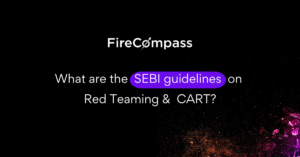Red Teaming & Continuous Automated Red Teaming (CART)
For the past decade, there have been unprecedented cases of cyber-attacks that have resulted in the exposure of private information and other related damages. According to RiskBased, cyber-attacks exposed 4.1 billion records in the first six months of 2019; and Juniper Research estimates this number to rise to 33 billion by 2023. Cybercriminals of today use sophisticated techniques and tools to break into online systems, and the only way to protect yourself against these high-level attacks is to have an understanding of how these cybercriminals operate and the techniques they use. This is achieved through the process of red teaming, which is a process of security assessment of the organization – where the ethical hackers of the company replicate real-life cyber-attack conditions to understand how ready the company is to defend against such attacks and also identify blind spots. The objective of these friendly attacks is to assess and strengthen your security measures’ ability to detect and respond to real-life attacks.
Continuous automated red teaming (CART) by Firecompass is different from the traditional red teaming process. It reduces the need for manual effort and runs continuously to discover the whole digital footprint of the organization and tests all assets continuously, not just a few assets.
Why Do We Need Regular Cyber Drills? How Continuous Automated Red Teaming (CART) Can Help
Cybersecurity should not be treated as an event, but rather a process. Cybercriminals devise their techniques and tools each day; An organization’s digital attack surface changes continuously; new connections are regularly established in an organization’s network; new mergers and acquisitions bring new users and policies into the organization’s network. All these changes create new security concerns that must be addressed forthwith.
Addressing these security concerns means carrying out regular and continuous security assessments and continuous recon activities that require continuous automated red teaming efforts like that by Firecompass. Continuous red teaming exercises ensure that a system or network is continuously monitored to test all the assets to identify vulnerabilities in the digital footprint of the organization without much manual effort.
Combat The Unpredictability Of Cyber Attacks
When regular system and network assessments lead to the discovery of new attack vectors that may have come up due to changes in the network, when IT and Information Security teams agree are unaware of all the IT assets used in the organization, and when penetration testing and analysis results in fewer results, then it’s time to carry out red teaming exercises.
With the unpredictability of when the cyberattacks happen to an organization, traditional red teaming exercise is not always effective. Red Teaming exercise is sometimes a point-in-time assessment and by the time reports come out, attack surface might change, new potential risks will emerge. Here comes the use for continuous automated red teaming exercises where the continuous recon is conducted the whole time to constantly keep an eye on the digital footprint and identify new and unknown internet exposed assets Also, this process is automated and reduces manual and duplication of work.
Therefore for coping with the unpredictability of cyberattacks it is always best to go for a continuous automated red teaming process like the one Firecompass provides.
Knowledge And Skills
A traditional red teaming project requires both the red and blue teams to be fully knowledgeable in their areas of responsibility: the red team must be equipped with the necessary skill to identify the vulnerabilities through simulated attacks, and the blue team must be knowledgeable enough to defend against those attacks.
Several Stages Of Red Teaming
A red teaming project is a methodical process divided into several successive phases, among which the most common ones are the formulation of threat intelligence and implementation of attack strategies.
In the first stage, a red teaming unit carries out threat intelligence, which is a framework used to provide guidance on conducting realistic simulated attacks against a system or network. Through threat intelligence, a threat analysis report is created. The second stage is the actual attacking exercises.
Some organizations opt to source threat intelligence from outside groups and conduct their own red teaming project using their own red team personnel. For this approach to be successful, an organization’s red team must be very knowledgeable and equipped with the necessary skills. The organization must also build a Security Operations Center (SOC) that is used to house all the Information Security teams responsible for the red teaming project.
Unfortunately, there are different obstacles to the success of this approach; for instance, budgets and expediency. And most of the time the recon is conducted for specific assets only which leaves the other assets vulnerable. The viable option, therefore, is to hire third-party groups to perform red teaming exercises. With a third-party contractor, an organization will save costs and will also have access to very skillful experts that can successfully implement its red teaming project.
With Firecompass’s Continuous Automated Red Teaming (CART) platform, you can not only combat the problems mentioned above but also conduct continuous recon thanks to the automated platform.
Conclusion
In an era when cybercriminals are devising sophisticated techniques and tools to be used for cyber-attacks, information security officers need to be prepared to resist such attacks. One way of achieving this preparedness is by opting for continuous automated red teaming solutions.
To avail Continuous Automated Red Teaming (CART) solution, you can contact Firecompass.




